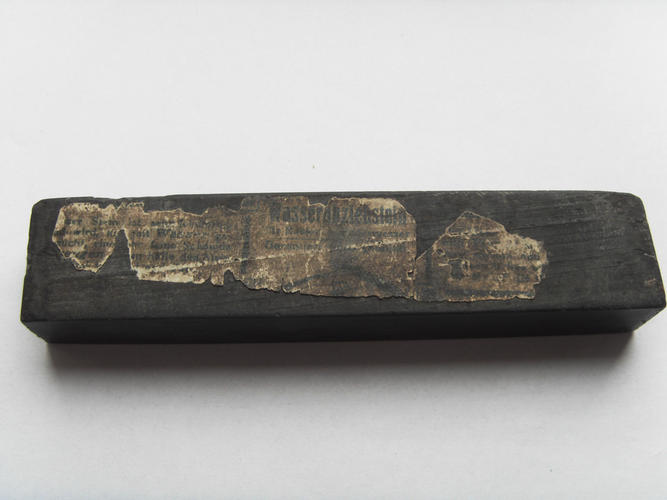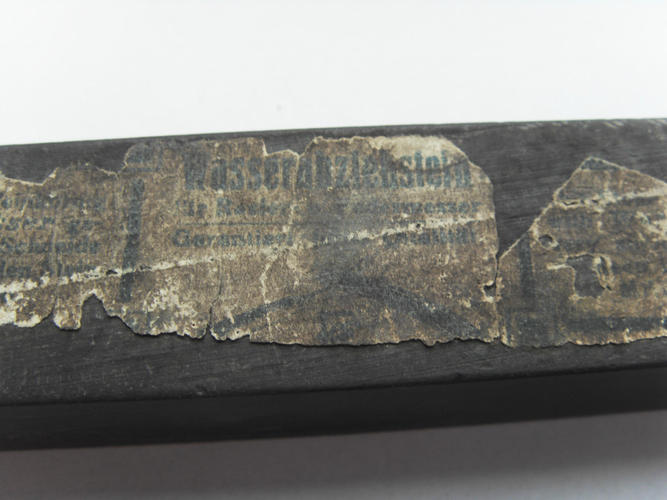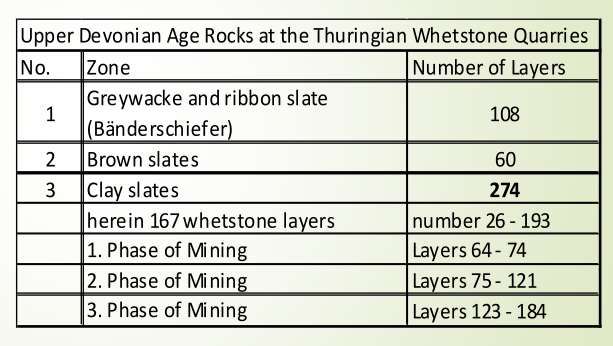Results 1 to 10 of 15
-
02-11-2016, 03:41 PM #1Member

- Join Date
- Feb 2016
- Location
- Denmark
- Posts
- 73
Thanked: 8 Anyone recognize this (thuri? escher?) label?
Anyone recognize this (thuri? escher?) label?
Hello, recently bought this on the bay I'm pretty sure it is a thuri of some sort. Does anyone recognize the label or have a stone with a complete version?


Text I can identify:
The middle section says "Wasserabziehstein für Rasier und Federmesser; Garantiert feinste (?) Qualität"
Left section, german: Dieser Stein ist sehr feinkörnig und wird nur mit Wasser gebraucht, eine sehr feine Schneide erzeugen. Man halte den Stein von (...)
Right section; same in english and Made in Germany (I suppose) at the bottom ...
Any help greatly appreciated.
Thanks in advance,
-
02-11-2016, 04:01 PM #2Historically Inquisitive



- Join Date
- Aug 2011
- Location
- Upstate New York
- Posts
- 5,780
- Blog Entries
- 1
Thanked: 4249
Thinks that means Waterstone for razors and penknifes, definitely not an Escher but Thuringian yes, should be a very nice finisher.
-
02-11-2016, 04:45 PM #3

Well it is definately a thuringian hone. The german designation Wasserabziehstein = waterwhetstone was typically used for thuringian hones.
-
02-11-2016, 04:54 PM #4

I'm betting the fact that it is obviously old will mean that it is a better quality hone no matter who the quarry/supplier was. I say that assuming they had more material to pick from back then, and chances are they culled out the rock with inclusions, and just sold first quality hones. That is my guess FWIW.
Be careful how you treat people on your way up, you may meet them again on your way back down.
-
02-11-2016, 05:19 PM #5

Well I cannot say if the label is really a very old one. But in general Jimmy, you are absolutely correct.
The thuringian waterwetstones are mined in slate quarries, that consist of in total 442 single layers. From these number 274 layers belong to the so-called clay slate. In this clay slate the whetstone layers were found. In the first phase of mining only the ten best whetstone layers have been mined. Later on, other layes have also been mined, so in the second phase additional 46 layers and in the last phase more than 60 layers have been mined and sold as thuringian waterhones (source: Max Volk: Das Oberdevon am Schwarzburer Sattel----, 1938).
I made a layer table for a presentaton some time ago:

The first phase layers have been the original ones, in the second phase mainly yellowish layers have been mined. The third phase layers had been mined because of lack of material from the previous layers, so they may have been of somehow less quality. Unfortunately there is no specific time frame mentioned somewhere, in which the different layers have been mined.
-
The Following 5 Users Say Thank You to hatzicho For This Useful Post:
AljuwaiedAK (02-21-2016), doorsch (02-14-2016), jarle (02-11-2016), JimmyHAD (02-11-2016), WW243 (02-18-2016)
-
02-11-2016, 05:21 PM #6Member

- Join Date
- Feb 2016
- Location
- Denmark
- Posts
- 73
Thanked: 8
Thanks for the input so far.
I've studied many of the lables of thuri/escher stones around here and normally it says s.th. like 'Genuine/Celebrated/Echter Thüringer etc. before Waterhone/Wasserabziehstein'. The fact that it (apparently) does not on this one kinda keeps me wondering.
The phrasing of the warning not to use the stone with oil seems a bit different from other examples as well.
"Man halte ..." instead of "Öl und Fett müssen ferngehalten werden".
Small details obviously, but very interesting - at least to me
...
-
02-11-2016, 06:01 PM #7

Peter, do you have any idea which layer in the chart the Eschers from the early period would have come out of ?
Even more interesting, to me, will be how the stone performs for you once you lay some razors on it. Keep us posted please.Be careful how you treat people on your way up, you may meet them again on your way back down.
-
02-11-2016, 07:05 PM #8Member

- Join Date
- Feb 2016
- Location
- Denmark
- Posts
- 73
Thanked: 8
-
02-11-2016, 07:19 PM #9Member

- Join Date
- Feb 2016
- Location
- Denmark
- Posts
- 73
Thanked: 8
Concerning the label; I think the more old fashioned phrasing and the mentioning of penknives might be indicative of an older stone - that's just speculation on my part of course...
First I'll have to check the posts on how to preserve lables, then I need to lap the stone. Can barely wait to try it out myself though, the only Thuri I've tried so far is a very small 'best quality' from MST. I'm still a honing infant btw. But I'll let you know when I get to it.
-
02-11-2016, 09:53 PM #10

If a label is really stuck on firmly I spray a document sealer called Krylon Preserve It on the label. Some labels will come off easily when wet. In that case I soak the label off and after drying put it in an envelope for safe keeping.
If you are new to honing save that stone for the finishing aspect of the honing. Thuringans are good finishers, but unlike coticules they are not efficient for heavier bevel work. At least not the ones I've had.Be careful how you treat people on your way up, you may meet them again on your way back down.


 16Likes
16Likes LinkBack URL
LinkBack URL About LinkBacks
About LinkBacks






 Reply With Quote
Reply With Quote



